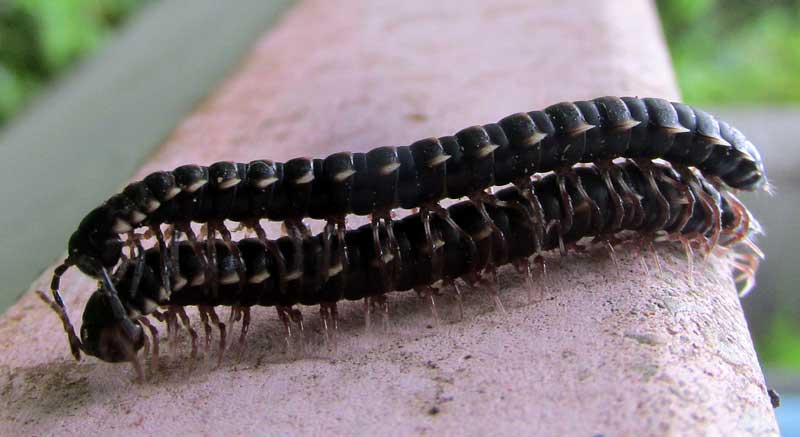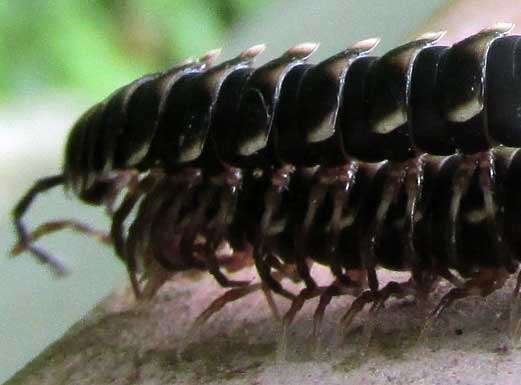Excerpts from Jim Conrad's
Naturalist Newsletter
from the August 14, 2016 Newsletter issued from Hacienda Chichen Resort beside Chichén Itzá Ruins; limestone bedrock; elevation ~39m (~128ft), N20.675°, W88.569°; central Yucatán state, MÉXICO
GREENHOUSE MILLIPEDE
On the outside washing trough, one millipede perched atop another, looking like a double-decker about an inch long (25mm), shown below:

I figured that they were mating. When I first saw them, the head end of the one on top was curved over the bottom one's side until the bottoms of their head-areas pressed against one another; It looked like one was nibbling at the throat of the other. Their rear ends didn't seem to be doing anything. In the above picture, they'd just stopped the "nibbling." Below, you can see them just looking around, and have a better view of the armor atop each body segment:

But, had that "nibbling" really been millipede sex? On the Internet I learned that among millipedes there are rainbows of mating structures and mating styles. In some millipede types, males deposit packets of sperm called spermatophores, which females pick up and insert where they're needed. In all other millipede groups, males bear one or two pairs of modified legs, called gonopods, with which sperm are transferred to the female. Gonopod location varies between groups. In some they're at the rear of the body, but in the vast majority of species they're on the seventh body segment from the front. Some species reproduce without sex -- parthenogenetically -- having few, if any, males.
On the Wikipedia Millipede Page I read that among the vast majority of millipede types, copulation occurs with the two individuals facing one another. To get the female receptive, the male may tap the female with his antennae, run along her back, offer edible glandular secretions, or, in the case of some pill-millipedes, stridulate, or "chirp." While copulation is taking place, in most millipede types, the male positions his seventh segment in front of the female's third segment.
So, I figure that the throat-nibbling I'd seen was a case of the twisted-around male getting or having his seventh segment in position against the female's third, and that it was millipede sex, or almost sex, before I disturbed them.
But, what kind of millipede among the approximately 12,000 known species do we have? I had a head start on the issue because back in Texas we found a millipede of very similar structure and size, which volunteer Bea in Ontario identified to genus level, shown at http:www.backyardnature.net/n/a/milliped.htm
The Texas millipede belonged to the Family Eurymerodesmidae so I began by looking for common millipede species in that family occurring in the Yucatan. Two very similar, very common, invasive "weedy" species very similar to those in our photos turned up. One was Orthoorpha coarctata, the other Oxidus gracilis.
The main difference between the two species visible without dissection is that on Oxidus gracilis the pale, backward-pointed, ear-like things (the lateral keels or "paranota") on the sides of each mid-body segment is proportionally longer and pointier than on Orthoorpha coarctata. On that shaky basis, I'm guessing that what's in our photos is OXIDUS GRACILIS, often known as the Greenhouse, Hothouse, Short-flange, or Garden Millipede.
Greenhouse Millipedes are thought to be native to Japan but they've been introduced practically worldwide. In the tropics they roam the ground, while in the temperate zone they prefer greenhouses. Around the Hacienda, at least during the rainy season, they're very common.
Most millipedes feed on decomposing vegetation, feces, or soil organic matter, helping in the decomposition of plant litter, and I'd guess that that's what ours are doing. At the Diplopoda.Org website the point is made that in the tropics where earthworm populations are low, millipedes play an important role helping microbes decompose leaf litter.